








The Famous 3 Way Crossing in Winfield, KS
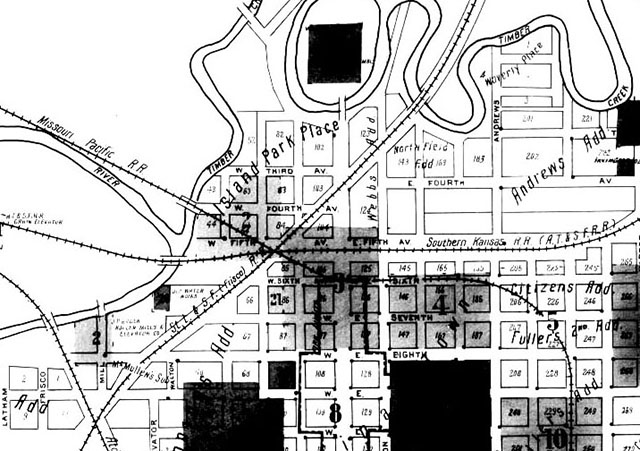
MoPac, Santa Fe & Frisco all cross at one point.
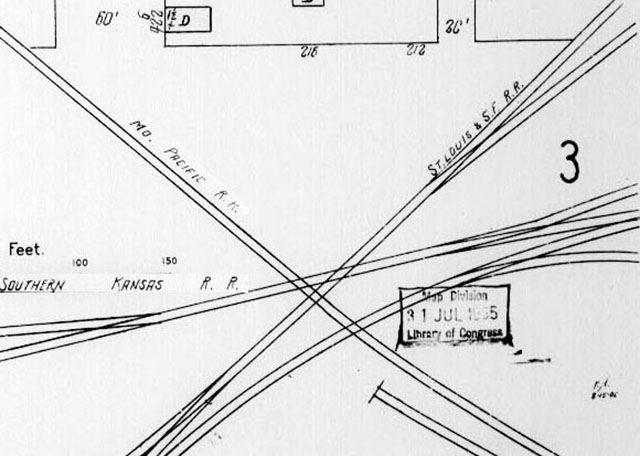
This is the actual track layout
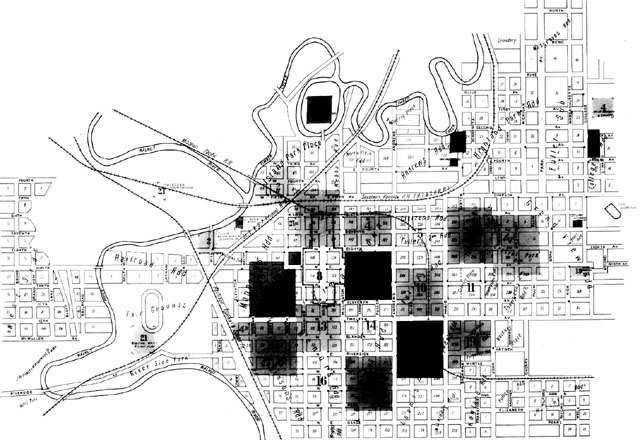
Track Layout for Winfield, 3 Railroads
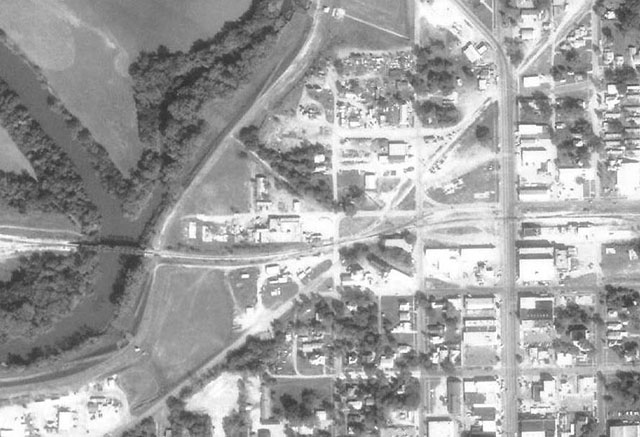
What it Looks Like Today from the Air
Of other interest to Railroaders are a track map of Winfield
Source Map #4 from 1918
Source Map #5 from 1918
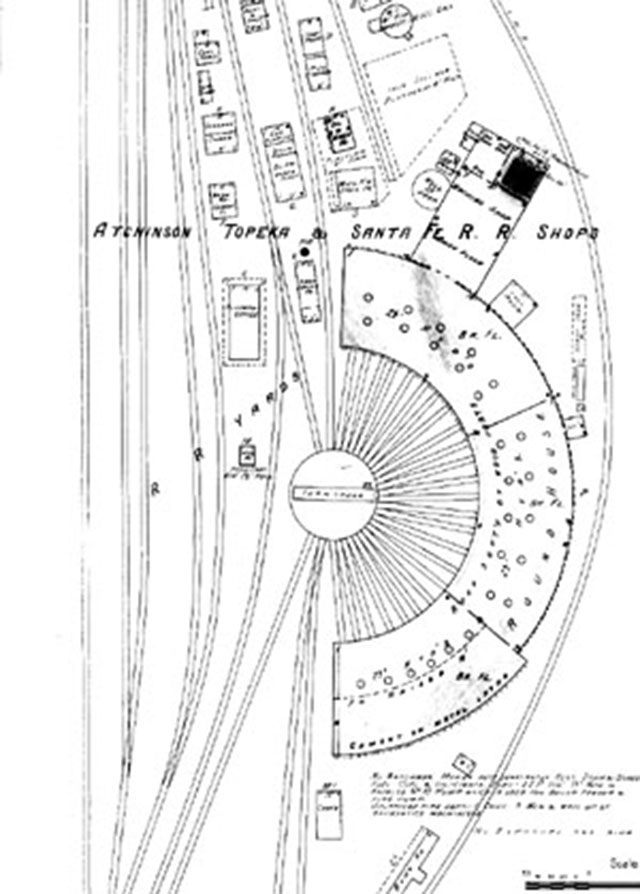
Also of interest is the old Arkansas City Roundhouse
Subject: 3-way RR crossing
Date: Thu, 23 Aug 2001
From: "Joe Watts"
Bill:
I don't know that there was anything special about the RR crossing in Winfield. It just happened that all three railroads found their way into town and met there. Usually, when even two railroads cross, there is some kind of safety arrangement like an interlocking tower with an operator to keep the trains separated. Winfield had an interlocking tower out west of town (straight north of the old rock quarry on the west side of the Walnut River (west 9th Ave.) At that crossing, the Santa Fe came into it from 5 different directions and the Missouri Pacific crossed the Santa Fe there on its way toward Wichita (many years ago). It had a 24-hour operator to keep all the trains sorted out. The crossing downtown didn't have any fast trains crossing it and not very many slow ones. The rule there was that each railroad had to stop,look, listen, and whistle. Whoever got there first had the right-of-way. Somewhere in the early 50's, I think, the Mo Pacific lost a bridge over the Arkansas north of Oxford and they never bothered to replace it. From that time until they quit altogether, they came into town from the east and turned around and went back. When I Ieft Winfield in 1960, the Mo Pacific was still switching the Crayola plant, Gott, and one grain elevator downtown.
The heyday for all three railroads in Winfield was back in the 30's. They literally had trains running everywhere. I worked for the Santa Fe summers in the early 50's and at that time, the Santa Fe had 12 passenger trains a day stopping at Winfield plus a lot of freight trains going through and switching in the yard west of Winfield. The Frisco had a train each way every day and the MoPac ran a train about three or four days a week.
Joe Watts
Subject: Re: A query from "The Winfield Site"
Date: Thu, 23 Aug 2001
From: ATSF run8 <run8@SUTV.COM>
Reply-To: SANTAFE Discussion List
Mike,
Traffic was not a problem. The crossing was in non block territory for all three railroads. There was a stop signal (red board) for each railroad in each direction. Trains would stop and proceed when it was safe to do so. In the 1942 Santa FE timetable, it states that the head brakeman would go to the crossing to see if it was safe for the train to cross and they would cross on his hand signals.
I can't ever remember seen the MP track cross here as it was taken up in the early 1960s if I remember right. The Arkansas River bridge near Oxford washed out on the MoP causing them to use the Santa Fe from Winfield to Mulvane, then back down to Belle Plaine. The Frisco disappeared about 1978 or 79 between Ark City and Beaumont. There is a small piece of Frisco track
still there that the Santa Fe serves. There is a short piece of track north of the old Southern Kansas that allows the Santa Fe (now SKOL) to switch a scrap dealer. There is also a spur off of the main line of the Ark City sub where the Frisco crossed there that the ATSF serves a fertilizer spot.
Keel Middleton
Subject: Re: A query from "The Winfield Site"
Date: Fri, 24 Aug 2001
From: bob burton
Reply-To: SANTAFE Discussion List
One of the ATSF's first automatic signal installations, and the first with US&S equipment, was at Winfield in 1898.
B Burton
Subject: More Railraod Stuff
Date: Tue, 28 Aug 2001
From: Tom Smith
To: Rex Flottman
After consulting references here are some corrections and additions:
The Missouri Pacific in Winfield started out as the "narrow gauge" Denver, Memphis & Atlantic. I say "narrow gauge" because the plans were changed to standard gauge in 1886, before any tracks had been laid. Eventually they had a line from McCracken to Pueblo and another from Chetopa through Coffeyville, Winfield, Belle Plain, Conway Springs, Kingman, and ending in Larned. It was absorbed to the MP in 1909. The portion from Conway Springs to Coffeyville was abandoned in bits between 1959 and 1992. The book claims that the last mile was abandoned in Winfield in 1995. However, this trackage that runs by my house was MP trackage, and it is still operated by the SEK.
The MP line East of AC was actually the Midland Valley. The MV is often called the Muskogee Roads. After a merger of three roads the steam locos actually said on the tender "Midland Valley - Kansas, Oklahoma & Gulf -Oklahoma City, Ada & Atoka". A line ran from Wichita through Belle Plaine, Arkansas City, Silverdale, and Pawhuska. It was merged into the MP in 1964. When I lived on 7th St the MP local that came by my house still had a caboose lettered "KO&G". All of the route was abandoned by1969.
The MP also had a line from AC into Dexter, built as the Grouse Creek Railroad, 1888.
The MP was merged into the Union Pacific in 1992. Despite saying that the UP was going to honor the MP heritage, MP blue quickly became UP Armour Yellow, and the MP name has pretty much disappeared from equipment. The joke about this at the time was that in order to honor the heritage of both of the merged roads the UP would combine the names of both. From the UP the name "Union" would be kept, and from the Missouri Pacific the name "Pacific" would be kept.
The Frisco was merged into the BN on 11/21/1980. The Beaumont branch was abandoned in 1977 due to a washout.
More than you ever wanted to know. Most of this from "Ghost Railroads of Kansas", an incomplete and frustrating book by Robert Collins.
And someday I'll describe the Southwestern Interurban.
Tom
Subject: Re: [Fwd: Re: 3-way RR crossing]
Date: Tue, 28 Aug 2001
From: Tom Smith
To: Rex Flottman
What I remember is from about 1970. The ATSF still left Winfield in 5 directions - I'm told this was the only place on the line this happened.
The Eastern Lines Eastern Division 4th District ran from AU Junction (near Chanute) through Winfield , then on to Wellington. This was later
taken over by the Southern Kansas & Oklahoma. The trackage East is still in use; I think there is occasional traffic on the track West of
Winfield, maybe only as far as Kellogg. The Eastern Lines Middle Division Third District ran from Newton through Winfield to Arkansas City. That is still in use by the BNSF (Bigger Now, Same F**king Railroad). In 1996 it was the Arkansas City Subdivision of the Kansas Division.
The Eastern Lines Middle Division Douglass District split off of the Easter Lines Middle Division 4th District in Augusta, ran through
Douglass, and ended at WN Junction, just North of Winfield. By the early 70's the Missouri Pacific got to Winfield from Wichita by a
circuitous route. There own track was intact from Wichita to Belle Plaine. At Belle Plaine they got on the ATSF Middle Div. 4th District,
then went North to Mulvane, where they took the (Eastern Lines) Middle Div. 3rd District to Winfield. After their Winfield work, they used the ATSF to access Ark City. I'm not sure when they stopped running East of either Winfield or Ark City.
The Frisco (SLSF) came to Winfield from Ark City. It crossed the Walnut River and 14th St. West of the Pecan Grove. The river abutments are still in place, the ones over 14th are long gone. The Frisco then ran across the fairgrounds, through a gate in the dike just South of Ninth
street, then crossed the ATSF and angled through town, leaving Eastward near the new swimming pool. At some point the line between Winfield was washed out, early 70's I think. Then the SLSF just ran to Winfield, servicing mostly Winfield Iron and Metal, and returned to AC. I'm not sure where that local really originated. The SLSF merged in BN in 1980 or 81. As a BN fan I'd hoped to see the BN actually operate to Winfield, but the line from AC was inactive by then.
Tom

